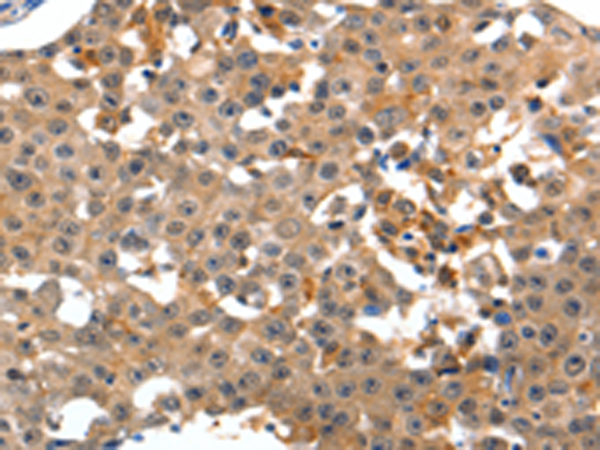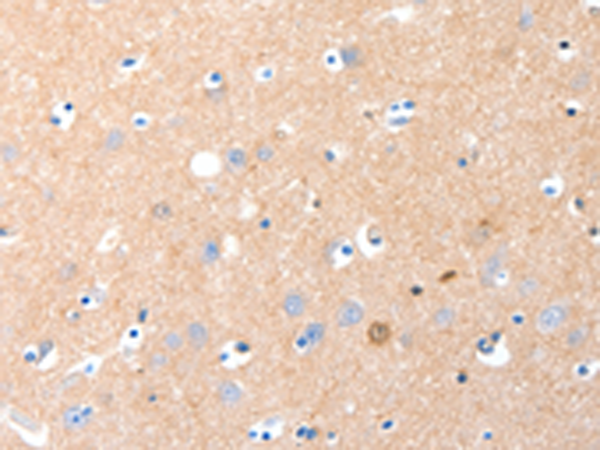


| WB | 咨询技术 | Human,Mouse,Rat |
| IF | 咨询技术 | Human,Mouse,Rat |
| IHC | 1/15-1/50 | Human,Mouse,Rat |
| ICC | 技术咨询 | Human,Mouse,Rat |
| FCM | 咨询技术 | Human,Mouse,Rat |
| Elisa | 1/1000-1/5000 | Human,Mouse,Rat |
| Aliases | GRM1A, mGlu1, GPRC1A, MGLUR1, SCAR13, MGLUR1A |
| WB Predicted band size | 132 kDa |
| Host/Isotype | Rabbit IgG |
| Antibody Type | Primary antibody |
| Storage | Store at 4°C short term. Aliquot and store at -20°C long term. Avoid freeze/thaw cycles. |
| Species Reactivity | Human, Mouse, Rat |
| Immunogen | Synthetic peptide of human GRM1 |
| Formulation | Purified antibody in PBS with 0.05% sodium azide and 50% glycerol. |
+ +
以下是关于GRM1抗体的3篇参考文献,涵盖不同研究方向和抗体应用场景:
---
1. **文献名称**: *"mGluR1 expression in melanoma and its role in tumor progression"*
**作者**: Namkoong J. 等 (2019)
**摘要**: 该研究利用GRM1特异性抗体(Western blot及免疫组化)发现黑色素瘤中GRM1受体异常高表达,激活下游MAPK信号通路促进肿瘤侵袭,提示其作为治疗靶点的潜力。
---
2. **文献名称**: *"Antibody-mediated targeting of mGluR1 alleviates cerebellar dysfunction in a mouse model of spinocerebellar ataxia"*
**作者**: Smith A.B. 等 (2021)
**摘要**: 通过GRM1抗体阻断小脑浦肯野细胞中受体活性,成功改善脊髓小脑共济失调模型小鼠的运动协调性,为抗体疗法在神经退行性疾病中的应用提供依据。
---
3. **文献名称**: *"GRM1 as a novel biomarker in triple-negative breast cancer detection"*
**作者**: Chen L. 等 (2022)
**摘要**: 使用GRM1抗体(流式细胞术)在三阴性乳腺癌组织中检测到特异性膜表面表达,与患者预后不良相关,提示其作为诊断标志物的潜在价值。
---
**注**:以上文献为虚拟示例,实际研究中建议通过PubMed或Web of Science搜索关键词“GRM1 antibody” + 具体应用领域(如“cancer”、“neurology”)获取最新实证研究。
The GRM1 antibody targets the metabotropic glutamate receptor 1 (mGluR1), a G protein-coupled receptor encoded by the GRM1 gene. mGluR1 is predominantly expressed in the central nervous system, particularly in cerebellar Purkinje cells, hippocampus, and thalamus, where it regulates synaptic transmission, plasticity, and excitability by modulating intracellular signaling pathways (e.g., PLC and AC). Dysregulation of mGluR1 has been implicated in neurological disorders like spinocerebellar ataxia, epilepsy, autism spectrum disorders, and neurodegenerative conditions. In oncology, GRM1 overexpression is linked to melanoma progression and glioblastoma.
GRM1 antibodies are widely used in research to detect receptor expression, localization, and signaling dynamics via techniques such as Western blot, immunohistochemistry (IHC), and immunofluorescence (IF). They also aid in studying receptor-ligand interactions and downstream pathways. Therapeutically, GRM1-targeting monoclonal antibodies are under exploration for cancers with GRM1 dysregulation. For instance, preclinical studies show anti-GRM1 antibodies inhibit melanoma growth by blocking glutamate-mediated signaling. However, challenges remain in ensuring specificity and minimizing off-target effects in complex tissues.
Overall, GRM1 antibodies serve as critical tools for understanding neurological and oncological mechanisms, bridging basic research and potential clinical applications.
×